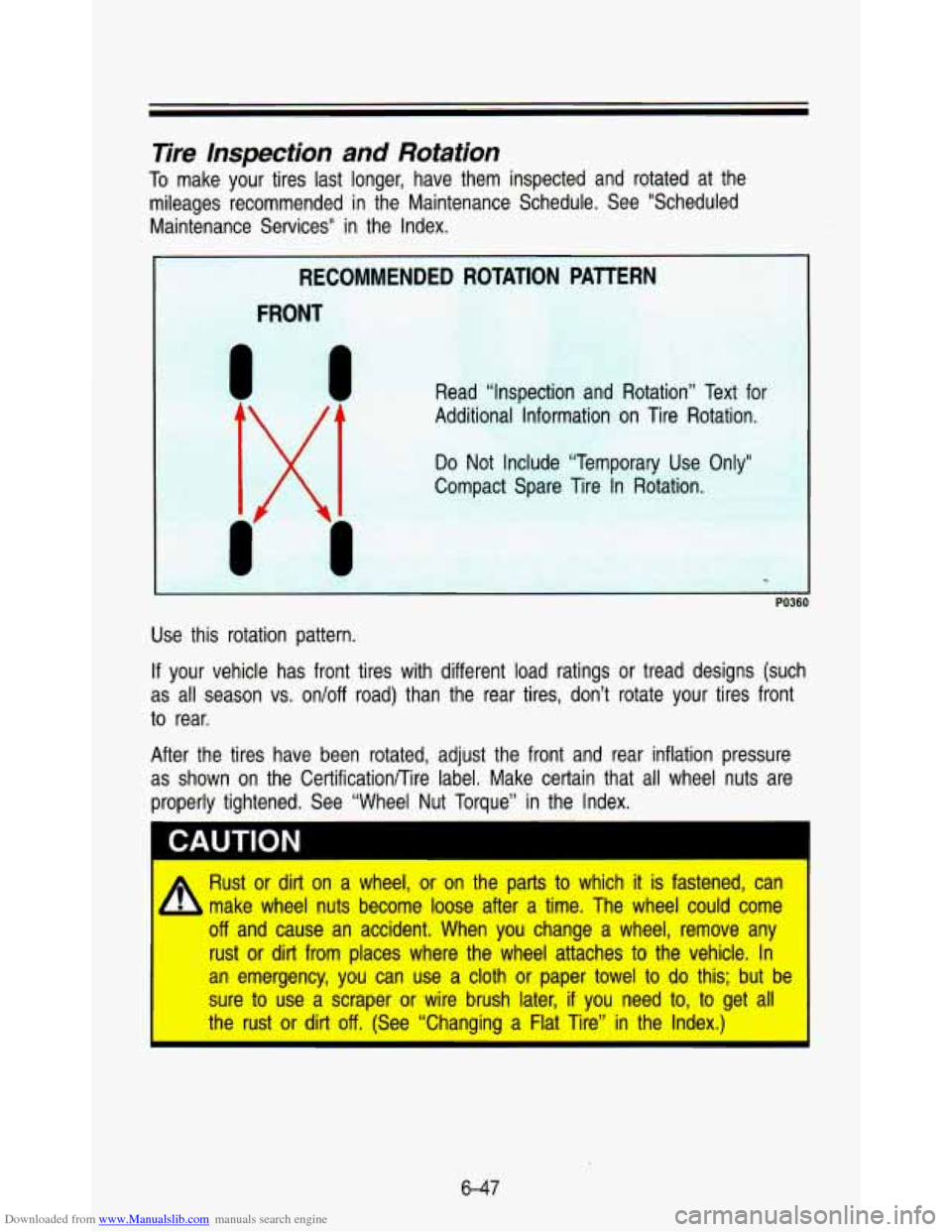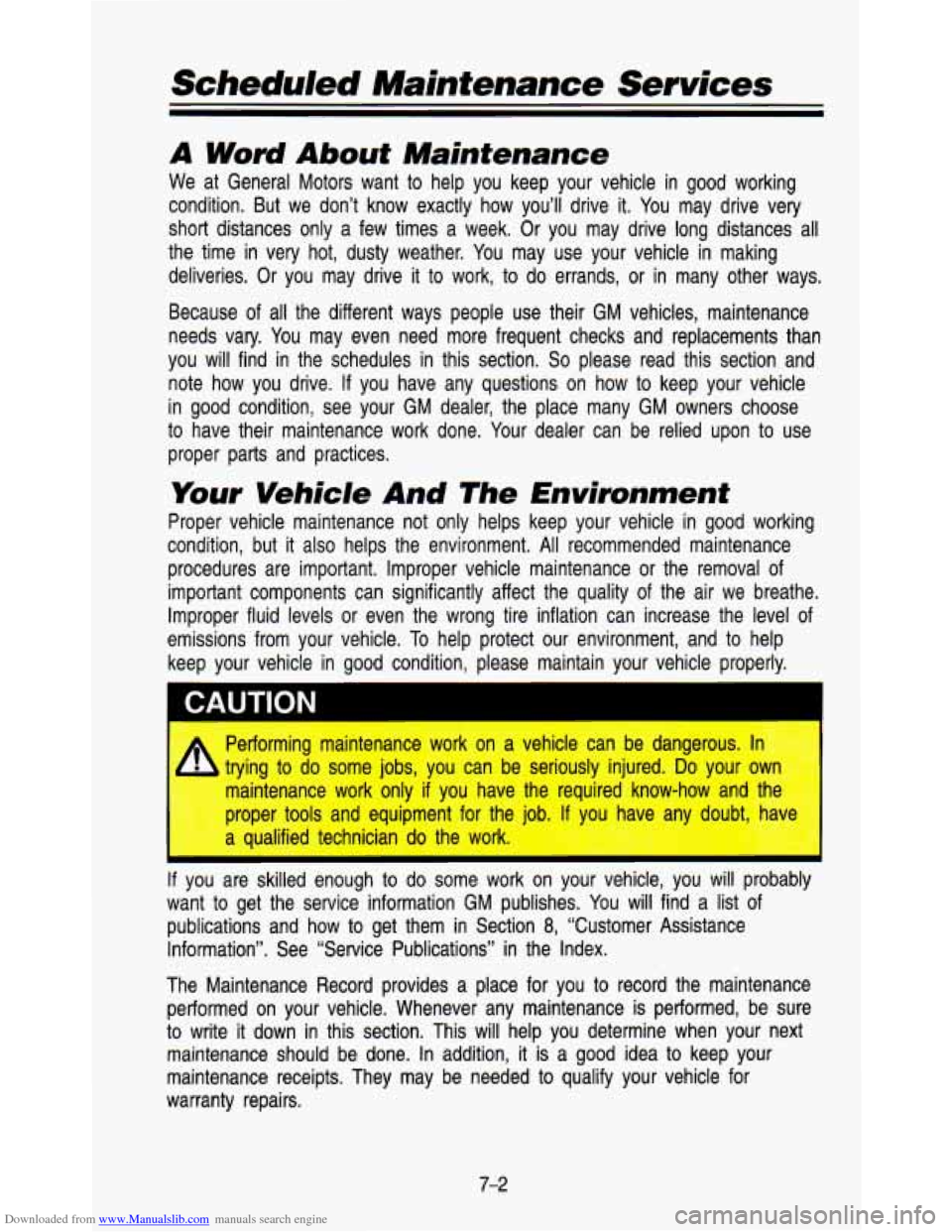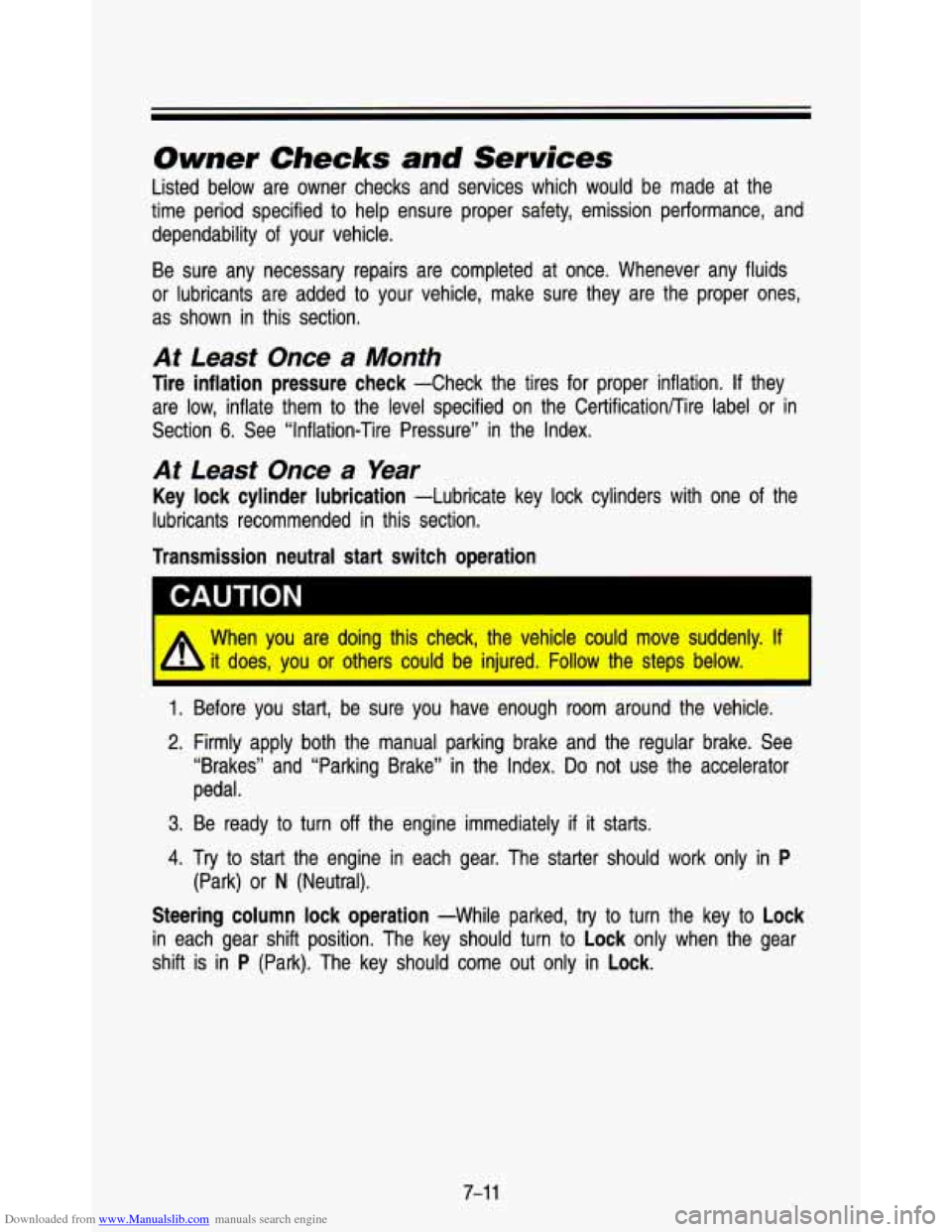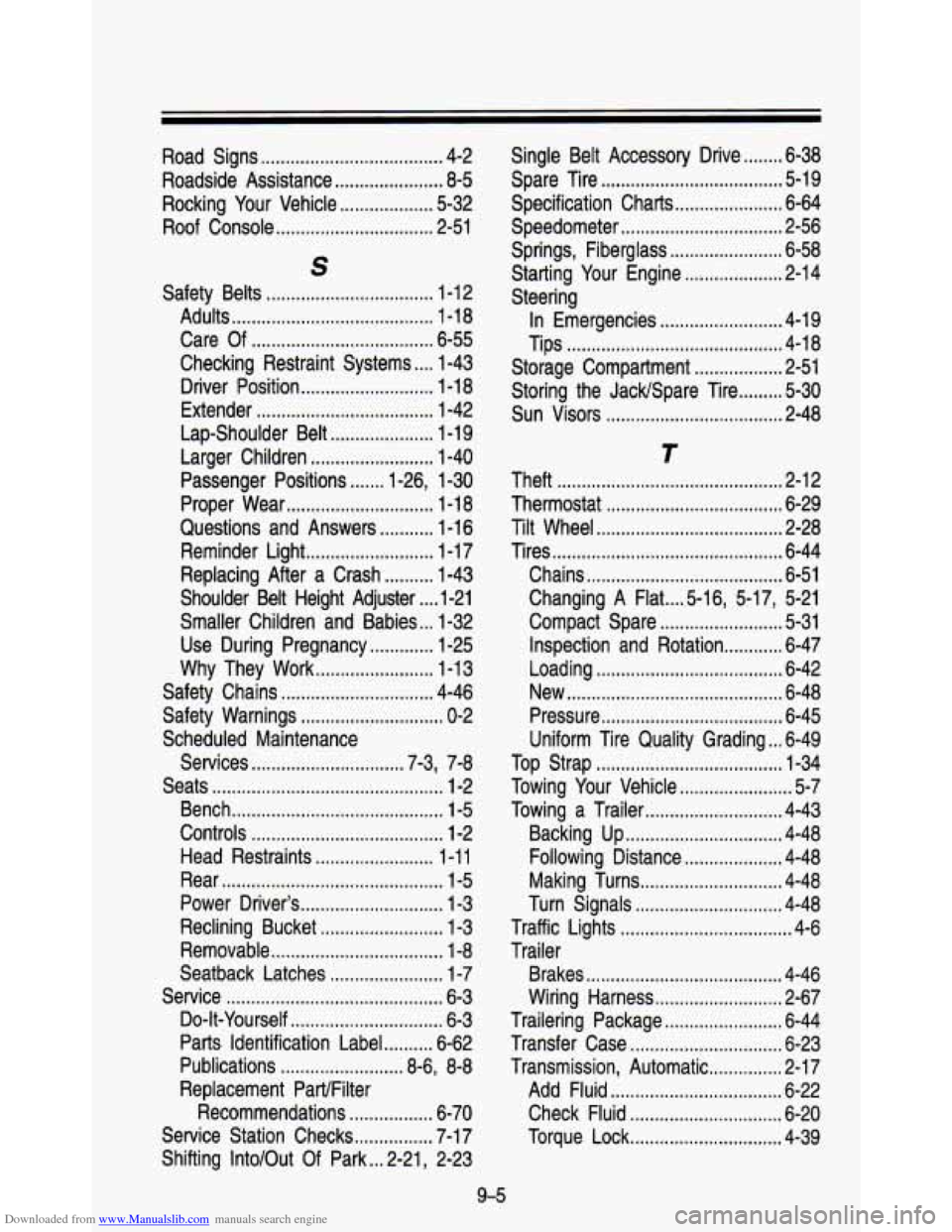1993 CHEVROLET ASTRO PASSENGER flat tire
[x] Cancel search: flat tirePage 283 of 345

Downloaded from www.Manualslib.com manuals search engine Tire Inspection and Rotation
To make your tires last longer, have them inspected and rotated a\
t the
mileages recommended in the Maintenance Schedule. See “Scheduled
Maintenance Services” in the Index.
Use this rotation pattern.
If your vehicle has front tires with different load ratings or tread designs (such
as all season vs. on/off road) than the rear tires, don’t \
rotate your tires front
to rear.
After the tires have been rotated, adjust the front and rear inflation pressure
as shown on the CertificationRire label. Make certain that all wheel nuts are
properly tightened. See “Wheel Nut Torque” in the Index.
CAUTION I
Rust or dirt on a wheel, or on the parts to which it is fastened, can
make wheel nuts become loose after a time. The wheel could come
.. off and cause an accident. When you change a wheel, remove an\
y
- - .-..-rust. -o,r dit-.from places where the wheel attaches to the vehicle. In
an emergency, you can use a cloth or paper towel to
do this; but be
sure
to use a scraper or wire brush later, if you need to, to get all
the rust or dirt off. (See “Changing a Flat Tire” in the Index.)
I
6-47
Page 286 of 345

Downloaded from www.Manualslib.com manuals search engine failure. The grade C corresponds to a level of performance which all
passenger car tires must meet under the Federal Motor Vehicle \
Safety
Standard
No. 109. Grades B and A represent higher levels of performance on
the laboratory test wheel than the minimum required by law.
Warning: The temperature grade for this tire is established for\
a tire that is
properly inflated and not overloaded. Excessive speed, underinfla\
tion,
or
excessive loading, either separately or in combination, can cause heat buildup
and possible tire failure.
These grades are molded on the sidewalls of passenger car tire\
s.
While the tires available as standard
or optional equipment on General Motors
vehicles may vary with respect to these grades, all such tires meet General
Motors performance standards and have been approved for use on \
General
Motors vehicles.
All passenger type (P Metric) tires must conform to Federal
safety requirements in addition to these grades.
Wheel Alignment and lire Balance
The wheels on your vehicle were aligned and balanced carefully \
at the
factory to give you the longest tire life and best overall pe\
rformance.
In most cases, you will not need
to have your wheels aligned again.
However,
if you notice unusual tire wear or your vehicle pulling one way or
the other, the alignment may need to be reset. If you notice your vehicle
vibrating when driving on a smooth road, your wheels may need \
to be
rebalanced.
Wheel Replacement
Replace any wheel that is bent, cracked or badly rusted. If wheel nuts keep
coming loose the wheel, wheel
bolts, and wheel nuts should be replaced. If
the wheel leaks air out, replace it (except some aluminum whe\
els, which can
sometimes be repaired). See your GM dealer if any of these c\
onditions exist.
Your dealer will know the kind of wheel you need.
Each new wheel should have the same load carrying capacity dia\
meter, width,
offset, and be mounted the same way as the one
it replaces.
If you need to replace any of your wheels, wheel bolts, or wheel nuts,
replace them only with new GM original equipment parts. This way, you will
be sure you have the right wheel, wheel bolts, and wheel nuts\
for your
vehicle.
6-50
Page 308 of 345

Downloaded from www.Manualslib.com manuals search engine Scheduled Maintenance Services
A Word About Maintenance
We at General Motors want to help you keep your vehicle in good working
condition. But we don’t know exactly how you’ll drive it. You may drive very
short distances only a few times a week. Or you may drive lo\
ng distances all
the time
in very hot, dusty weather. You may use your vehicle in making
deliveries. Or you may drive
it to work, to do errands, or in many other ways.
Because
of all the different ways people use their GM vehicles, maintenance
needs vary. You may even need more frequent checks and replacements than
you will find in the schedules in this section.
So please read this section and
note how you drive. If you have any questions on how
to keep your vehicle
in good condition, see your GM dealer, the place many
GM owners choose
to have their maintenance work done. Your dealer can be relied upon to use
proper parts and practices.
Your Vehicle And The Environment
Proper vehicle maintenance not only helps keep your vehicle in good working
condition, but it also helps the environment.
All recommended maintenance
procedures are important. Improper vehicle maintenance or the re\
moval of
important components can significantly affect the quality of the air we breathe.
Improper fluid levels or even the wrong tire inflation can inc\
rease the level of
emissions from your vehicle. To help protect our environment, and to help
keep your vehicle in good condition, please maintain your vehic\
le properly.
CAUTION
. Performing maintenance work on a vehicle can be dangerous. ...
trying to do some jobs, you can be seriously injured. Do your own
maintenance work only
if you have the reauired know-how and the
proper
tools and equipment for the iob. IOU have ar doubt. have
a qualified technician do the
WOrK. I
If you are skilled enough to do some work on your vehicle, you will probably
want
to get the service information GM publishes. You will find a list of
publications and how to get them in Section
8, “Customer Assistance
Information”. See “Service Publications’’ in the Index.
The Maintenance Record provides a place for you to record the maintenance
performed on your vehicle. Whenever any maintenance is performed, be sure
to write
it down in this section. This will help you determine when your next
maintenance should be done. In addition,
it is a good idea to keep your
maintenance receipts. They may be needed to qualify your vehicle for
warranty repairs.
7-2
Page 317 of 345

Downloaded from www.Manualslib.com manuals search engine Owner Checks and Services
Listed below are owner checks and services which would be made at the
time period specified to help ensure proper safety, emission performance, and
dependability of your vehicle.
Be sure any necessary repairs are completed at once. Whenever \
any fluids
or lubricants are added to your vehicle, make sure they are the \
proper ones,
as shown in this section.
At Least Once a Month
Tire inflation pressure check -Check the tires for proper inflation. If they
are low, inflate them
to the level specified on the CertificationRire label or in
Section
6. See “Inflation-Tire Pressure” in the Index.
At Least Once a Year
Key lock cylinder lubrication -Lubricate key lock cylinders with one of the
lubricants recommended in this section.
Transmission neutral start switch operation
I A When you are doing this check, the vehicle could move suddenly\
. If I
it does, you or others could be injured. Follow the steps below. I L
1. Before you start, be sure you have enough room around the vehicle.
2. Firmly apply both the manual parking brake and the regular brake. See
“Brakes” and “Parking Brake” in the Index.
Do not use the accelerator
pedal.
3. Be ready to turn off the engine immediately if it starts.
4. Try to start the engine in each gear. The starter should work only in P
Steering column lock operation -While parked, try to turn the key to Lock
in each gear shift position. The key should turn to Lock only when the gear
shift is in
P (Park). The key should come out only in Lock.
(Park) or N (Neutral).
7-1 1
Page 338 of 345

Downloaded from www.Manualslib.com manuals search engine c
Carbon Monoxide ..... 2.24. 4.42. 4-47
Capacities and Specifications
...... 6-64
Cassette Tape Player
Catalytic Converter
....................... 6-41
Certification/Tire Label
.................. 6-42
Changing
A Flat Tire .. 5.16. 5.17. 5-21
Charging System Light
................ 2-65
Chemical Paint Spotting
.............. 6-58
Child Restraints
............................ 1-33
Cigarette Lighter/Ashtrays
............ 2-50
Cleaning
Glass
.......................................... 6-55
Inside
of Vehicle ....................... 6-53
Instrument Panel
....................... 6-55
Outside of Vehicle .................... 6-56
Special Problems
...................... 6-54
Vinyl or Leather
........................ 6-55
Windshield
................................. 6-56
Comfort Controls
............................ 3-3
Constant Velocity Joints (All Wheel Drive Only)
............. 6-40
Coolant (See “Engine”)
Cooling System
............................ 6-64
Crankcase
..................................... 6-65
Cruise Control
............................... 2-35
Increase Speed
......................... 2-38
On Hills
..................................... 2-39
Passing
...................................... 2-39
Reduce Speed
.......................... 2-39
Resume a Set Speed
.............. 2-37
To Get Out of
........................... 2-40
To Set
....................................... 2-36
Hearing or Speech Impaired
..... 8-3
Procedure
.................................... 8-2
(See “Audio Systems”)
Clock
..... 3-12, 3-14. 3-17, 3-20, 3-24
Customer Assistance for the Customer Satisfaction
D
Finish ......................................... 6-57
Sheet Metal
............................... 6-57
Daytime Running Lights
(Canada Only)
.................... 2-43, 2-66
Indicator Light
.................. 2-43, 2-66
Defogger, Rear Window
................. 3-8
Dome Lights
.................................. 2-44
Doors
............................................... 2-5
Power Locks
.............................. 2-11
Rear
............................................. 2-7
Side
.............................................. 2-5
Side, Sliding
................................ 2-6
Sliding Tracks
............................ 6-40
At Night
........................... 4-23, 4-25
City
............................................. 4-30
Control
Of A Vehicle ................ 4-12
Defensive
..................................... 4-8
Highway Hypnosis
..................... 4-34
Hydroplaning
.............................. 4-27
In
A Blizzard ............................. 4-42
In Deep Snow
........................... 4-43
In Fog, Mist and Haze
............. 4-28
In Sand, Mud, Ice or Snow
..... 5-32
In The Rain
..................... 4-26, 4-28
Long Distance
........................... 4-33
Loss
of Control ......................... 4-22
Night Vision
............................... 4-24
On Curves
................................. 4-18
On Grades
................................. 4-48
On Hill and Mountain Roads
... 4-35
On Snow or Ice
........................ 4-40
On The Freeway
....................... 4-31
Skidding
..................................... 4-22
Through Deep Water
................ 2-16
Winter
......................................... 4-40
With a Trailer
............................ 4-47
Drunken Driving
.............................. 4-9
Damage
Locks
.......................................... 2-10
Driving
9-2
Page 339 of 345

Downloaded from www.Manualslib.com manuals search engine ..
.
E
Engine Block Heater
..................... 2.16. 3-9
Coolant
............................ 5.11. 6-26
Coolant Temperature Gage
...... 2-60
Cover
......................................... 6-1 5
Exhaust ............................ 2.24. 6-41
Fan Noise
.................................. 5-1 6
Identification
..................... 6.60. 6-64
Oil (See “Oil”) Overheating
................................. 5-8
Running While Parked
... 2.22. 2-25
Equipment. Add-on
...................... 6-44
Exhaust System
............................ 6-41
F
Finish Care
........................................... 6-56
Damage
..................................... 6-57
Automatic Transmission
............ 6-20
Brake
......................................... 6-32
Capacities
.................................. 6-64
Coolant
............................ 5.11. 6-26
Leak Check
............................... 6-34
Power Steering
......................... 6-30
Transfer Case
........................... 6-23
Windshield Washer
................... 6-31
Fog Lamps
.................................... 2-42
Four-wheel Antilock
..................... 4-1 5
Front Seats ..................................... 1-2
Fuel
................................................. 6-4
Gage
.......................................... 2-63
In Foreign Countries
................... 6-6
Regulator
................................... 2-1 5
Tank Capacity ........................... 6-65
Fuse Block
.................................... 6-63
Fuses and Circuit Breakers
......... 6-68
Fluid
Filling Your Tank
......................... 6-6
G
Gages
Fuel ............................................ 2-63 ....
Voltmeter .................................... 2-64
Gasolines for Cleaner Air
.............. 6-5
H
Hatch Release Switch .................. 2-27
Hazard Warning Flashers
.............. 5-2
Head Restraints
............................ 1-11
Headlights
...................................... 6-35
High Beams
..................... 2.66. 4-24
High-Low Beam
......................... 2-31
Reminder Light
.......................... 2-44
Heating System
.............................. 3-5
Fan Lever
.................................... 3-5
Rear
............................................. 3-7
Temperature Lever
...................... 3-5
Highway Hypnosis
........................ 4-34
Hitches Hood Block Heater.,
............................ 2-16
Function Lever
............................ 3-5
4-46
...........................................
Latches and Hinge ................... 6-40
Release
........................................ 6-8
Horn
............................................... 2-28
Hydroplaning
................................. 4-27
I
If You’re Stuck in Sand. Mud.
Ice or Snow
.............................. 5-32
Ignition Switch
............................... 2-13
Inflation-Tire Pressure
................... 6-45
Instrument Cluster
........................ 2-52
Standard
.................................... 2-55
Digital
......................................... 2-52
J
Jack Storage ................................. 5-18
Jump Starting
.................................. 5-3
9-3
Page 341 of 345

Downloaded from www.Manualslib.com manuals search engine Road Signs ..................................... 4-2
Roadside Assistance ...................... 8.5
Rocking Your Vehicle ................... 5-32
Roof Console ................................ 2-51
S
Safety Belts .................................. 1-12
Care Of ..................................... 6-55
Checking Restraint Systems .... 1-43
Driver Position ........................... 1-1 8
Extender .................................... 1-42
Lap-Shoulder Belt ..................... 1-19
Larger Children ......................... 1-40
Passenger Positions ....... 1-26, 1-30
Proper Wear .............................. 1-1 8
Questions and Answers ........... 1-16
Reminder Light .......................... 1-1 7
Replacing After a Crash .......... 1-43
Shoulder Belt Height Adjuster .... 1-21
Smaller Children and Babies ... 1-32
Use During Pregnancy ............. 1-25
Why They Work ........................ 1-13
Safety Chains ............................... 4-46
Safety Warnings ............................. 0-2
Scheduled Maintenance
Services
............................... 7-3, 7-8
Seats ............................................... 1-2
Bench ........................................... 1-5
Controls ....................................... 1-2
Head Restraints ........................ 1-1 1
Rear ............................................. 1-5
Power Driver’s ............................. 1-3
Reclining Bucket ......................... 1-3
Removable ................................... 1-8
Seatback Latches ....................... 1-7
Service ............................................ 6-3
Do-It-Yourself ............................... 6-3
Parts Identification Label .......... 6-62
Publications ......................... 8-6, 8-8
Replacement ParVFilter Recommendations
................. 6-70
Service Station Checks ................ 7-1 7
Adults ......................................... 1-18
Shifting IntolOut Of Park ... 2-21, 2-23
Single Belt Accessory Drive ........ 6-38
Spare Tire ..................................... 5-19
Specification Charts ...................... 6-64
Speedometer ................................. 2-56
Springs, Fiberglass ....................... 6-58
Starting Your Engine .................... 2-14
Steering
In Emergencies
......................... 4-19
Tips ............................................ 4-18
Storage Compartment .................. 2-51
Storing the JacWSpare Tire ......... 5-30
Sun Visors .................................... 2-48
T
Theft .............................................. 2-12
Thermostat .................................... 6-29
Tilt Wheel ...................................... 2-28
Tires ............................................... 6-44
Chains ........................................ 6-51
Changing A Flat ..A-16, 5.17, 5-21
Compact Spare ......................... 5-31
Inspection and Rotation ............ 6-47
Loading ...................................... 6-42
New ............................................ 6-48
Pressure ..................................... 6-45
Uniform Tire Quality Grading ... 6-49
Top Strap ...................................... 1-34
Towing Your Vehicle ....................... 5-7
Towing a Trailer ............................ 4-43
Backing Up ................................ 4-48
Following Distance .................... 4-48
Making Turns ............................. 4-48
Turn Signals .............................. 4-48
Traffic Lights ................................... 4-6
Trailer
Brakes
........................................ 4-46
Wiring Harness .......................... 2-67
Trailering Package ........................ 6-44
Transfer Case ............................... 6-23
Transmission, Automatic ............... 2-17
Add Fluid ................................... 6-22
Check Fluid ............................... 6-20
Torque Lock ............................... 4-39
9-5